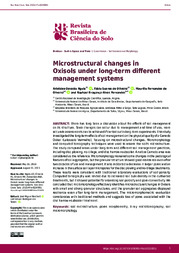Microstructural changes in Oxisols under long-term different management systems.
Microstructural changes in Oxisols under long-term different management systems.
Author(s): NGOLO, A. O.; OLIVEIRA, F. S. de; OLIVEIRA, M. F. de; FERNANDES, R. B. A.
Summary: There has long been a discussion about the effects of soil management on its structure. Since changes can occur due to management and time of use, more accurate assessments can be achieved if carried out in long-term experiments. This study investigated the long-term effects of soil management on the physical quality of a Cerrado Oxisol (Latossolo Vermelho), focusing on microstructural changes. Micromorphology and computed tomography techniques were used to assess the soil’s microstructure. The study compared areas under long-term and different soil management practices, including disc plowing, no-tillage, and disc harrow+subsoiler. A native Cerrado area was considered as the reference. Micromorphology revealed some changes in the pedological features of soil aggregates, but the granular structure showed good resistance even after two decades of use and management. It also indicated a decrease in larger pores and an increase in the surface soil layer micropores for the disc plowing and no-tillage treatments. These results were consistent with traditional laboratory evaluations of soil porosity. Computed tomography was limited due to increased soil bulk density in the cultivated treatments, but it showed potential for assessing soil porosity and pore connectivity. We concluded that micromorphology effectively identifies microstructural changes in Oxisols with small and strong granular structures, and the granular soil aggregates displayed resilience even after long-term management. The micromorphometric evaluation corroborates with traditional methods and suggests loss of pores associated with the disc harrow+subsoiler treatment.
Publication year: 2023
Types of publication: Journal article
Unit: Embrapa Maize & Sorghum
Observation
Some of Embrapa's publications are published as ePub files. To read them, use or download one of the following free software options to your computer or mobile device. Android: Google Play Books; IOS: iBooks; Windows and Linux: Calibre.
Access other publications
Access the Agricultural Research Database (BDPA) to consult Embrapa's full library collection and records.
Visit Embrapa Bookstore to purchase books and other publications sold by Embrapa.

